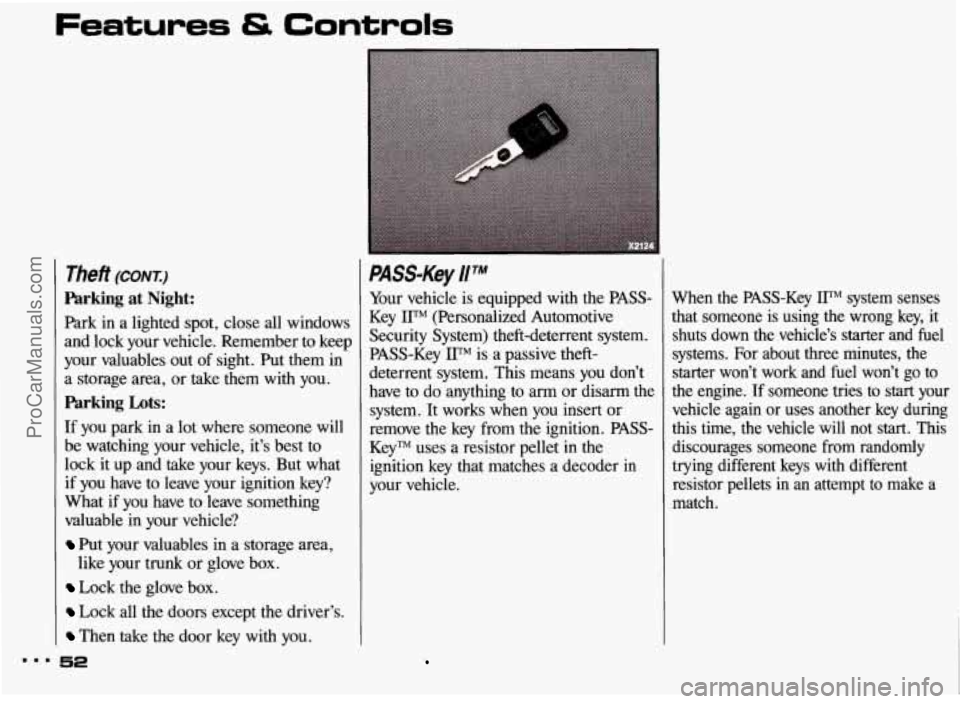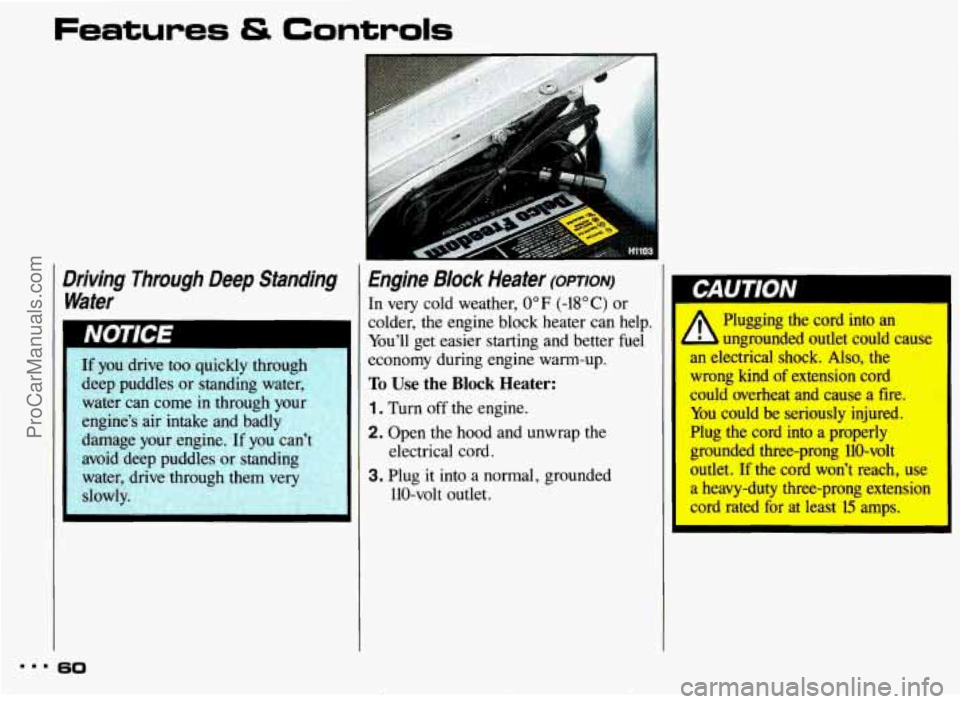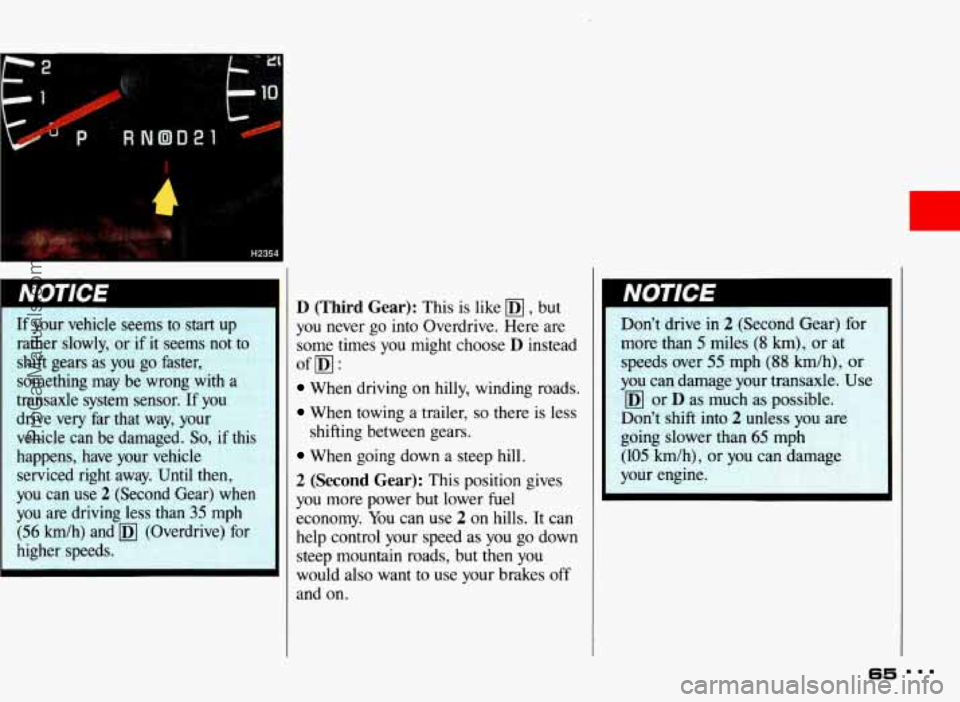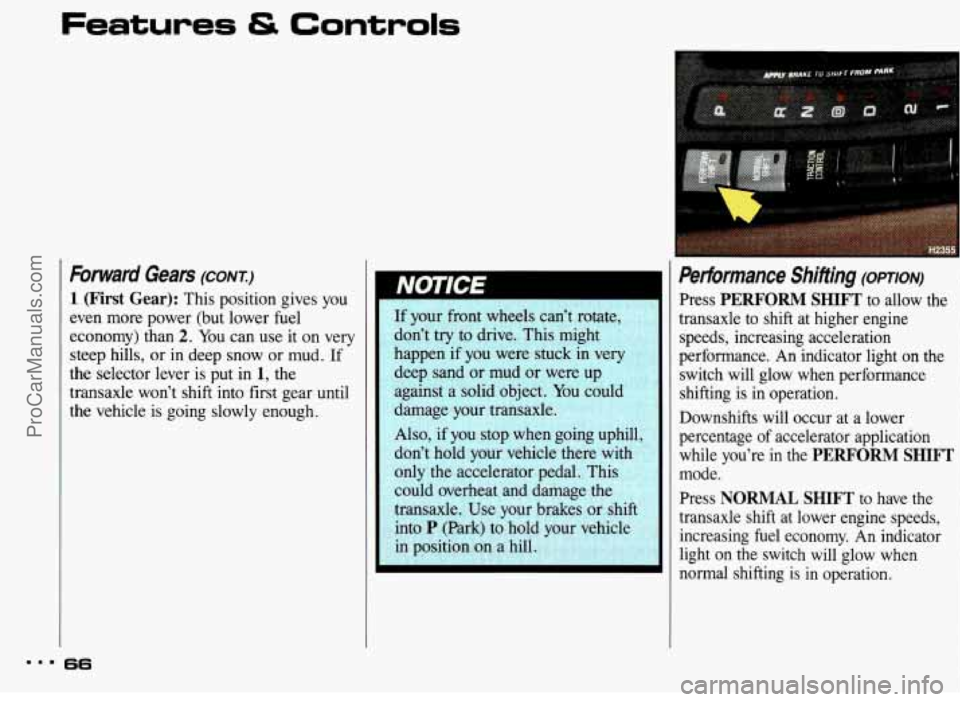Page 8 of 322
r
These symbols are on some of your
controls:
Windshield Wipers
Windshield Washer
Headlight Washers
Windshield Defroster
Rear Window Defogger
Q@
Ventilating Fan
Power Window
These symbols are used on warning and
indicator lights:
L
I
a
Engine Coolant Temperature
Battery Charging System
Fuel
Engine
Oil Pressure
Brake
Anti-Lock Brakes
ProCarManuals.com
Page 53 of 322

Features & Controls
Theft (CONI)
Parking at Night:
Park in a lighted spot, close all windows
and lock your vehicle. Remember to keep
your valuables out of sight. Put them in
a storage area, or take them with you.
Parking Lots:
If you park in a lot where someone will
be watching your vehicle, it’s best to
lock it up and take your keys. But what
if you have to leave your ignition key?
What
if you have to leave something
valuable in your vehicle?
Put your valuables in a storage area,
Lock the glove box.
Lock all the doors except the driver’s.
Then take the door key with you.
like
your trunk or glove box.
52
PASS-Key /ITM
Your vehicle is equipped with the PASS-
Key
IFM (Personalized Automotive
Security System) theft-deterrent system.
PASS-Key
IFM is a passive theft-
deterrent system. This means you don’t
have to do anything to arm or disarm the
system. It works when you insert
or
remove the key from the ignition. PASS-
KeyTM uses a resistor pellet in the
ignition key that matches a decoder in
your vehicle.
When the PASS-Key IFM system senses
that someone is using the wrong key, it
shuts down the vehicle’s starter and fuel
systems. For about
three minutes, the
starter won’t work and fuel won’t go to
the engine.
If someone tries to start your
vehicle again
or uses another key during
this time, the vehicle will not start. This
discourages someone from randomly
trying different keys with different
resistor pellets in an attempt to make
a
match.
ProCarManuals.com
Page 61 of 322

Features & Controls
Driving Through Deep Standing Water
.. - .
If you drive too quickly through
deep puddles or standing water,
water can come in through your
engine’s air intake and badly
damage
your engine. If you can’t
avoid deep puddles or standing
water, drive through them very
slowly.
Engine Block Heater (opTIoN)
In very cold weather, 0°F (-18” C) or
colder,
the engine block heater can help.
You’ll get easier starting and better fuel
economy during engine warm-up.
To Use the Block Heater:
1 . Turn off the engine.
2. Open the hood and unwrap the
3. Plug it into a normal, grounded
electrical
cord.
110-volt outlet.
b!!
A
Plugging the cord into an
ungrounded outlet could cause
an electrical shock. Also, the
wrong kind of extension cord
could overheat and cause a fire. You could be seriously injured.
Plug the cord into a properly
grounded three-prong 110-volt
outlet. If the cord won’t reach, use
a heavy-duty three-prong extension
cord rated for at least 15 amps.
... 60
ProCarManuals.com
Page 66 of 322

If your vehicle seems to start up
rather slowly, or if it seems not to
shift gears
as you go faster,
something may be wrong with a
transaxle system sensor. If you
drive very far that way, your
vehicle can be damaged.
So, if this
happens, have your vehicle
serviced right away. Until
then,
you can use 2 (Second Gear) when
vou are driving less than
35 mDh
i56 km/h) anza (0
higher speeds.
D (Third Gear): This is like , but
you never go into Overdrive. Here are
some times you might choose
D instead
When driving on hilly, winding roads.
When towing a trailer, so there is less
When going down a steep hill.
2 (Second Gear): This position gives
you more power but lower fuel
economy.
You can use 2 on hills. It can
help control your speed as you go down
steep mountain roads, but then you
would also want to use your brakes
off
and on.
ofm:
shifting between gears.
r
Don't drive in 2 (Second Gear) for I
more than 5 miles (8 km), or at
speeds over
55 mph (88 km/h), or
you
can damage your transaxle. Use
or
D as much as possible.
Don't shift into
2 unless you are
going slower than
65 mph
(105 km/h), or you can damage
your engine.
65 mmm
ProCarManuals.com
Page 67 of 322

Features & Controls
Forward Gears (CONT.)
1 (First Gear): This position gives you
even more power (but lower fuel
economy) than
2. You can use it on very
steep hills, or in deep snow or
mud. If
the selector lever is put in
1, the
transaxle won’t shift into first gear until
the vehicle is going slowly enough.
66
If your front wheels can’t rotate,
don’t try to drive. This might
happen if you were stuck
in very
deep sand or mud or were up
against a solid object. You could
damage your transaxle.
Also,
if you stop when going uphill,
don’t hold your vehicle there with
only the accelerator pedal. This
could overheat and damage the
transaxle.
Use your brakes or shift
into
P (Park) to hold your vehicle
in position
on a hill.
Performance Shifting (opTIoN)
Press PERFORM SHIFT to allow the
transaxle to shift at higher engine
speeds, increasing acceleration
performance. An indicator light on the
switch will glow when performance
shifting is in operation.
Downshifts will occur at a lower
percentage
of accelerator application
while you’re in the
PERFORM SHIFT
mode.
Press
NORMAL SHIFT to have the
transaxle shift at lower engine speeds, increasing fuel economy. An indicator
light on the switch will glow when
normal shifting is in operation.
ProCarManuals.com
Page 96 of 322

r
The Instrument &ne/-
bur Information System
Your instrument panel is designed to let
you know at a glance how your vehicle
is running. You’ll know how fast you’re
going, how much fuel you’re using, and
many other things you’ll need to drive
safely and economically.
The main components of your
instrument panel are:
1. Light Controls/Twilight Sentinel
2. Side Vent
3. Turn SignaUHeadlight Beam Lever
4. Electronic Compass (Option) (Option)
5. Instrument Cluster
6. Ignition Switch
7. Driver Information Center
(Option)
8. Trip Odometer Reset
9. Gage Cluster
Defogger
1 0. Climate Controls/Rear Window
1 1 . Lighter
i 2. Temperature Sensor
1 3. Glove Box
14. Side Vents
1 5. Center Vent
1 6. Audio System
17. Gear Shift Lever
1 8. Ashtray
19. Console Switch Bank (Option)
20. Gain Control (Option)
21. Hazard Warning Flashers Switch
22. Horn
23. Steering Wheel Audio Controls
24. Head-Up Display Control (Option)
25. Parking Brake Release
26. Hood Release
27. Tilt Wheel Lever (Option)
95 mmm
ProCarManuals.com
Page 105 of 322
Features & Controls
Battery Warning Light (CONI:)
your accessories, such as. the radio and
climate control system.
Some clusters with gages do
not have a
battery warning light. They have a
CHECK GAGES warning to indicate a
problem. Vehicles with the supercharged
engine also have a similar battery
warning light.
Malfunction Indicator Lamp
(Service Engine Soon Light)
A computer monitors operation of your
fuel, ignition and emission controls
systems. This light should come on
when the ignition is on but the engine is
not running, as a check to show you it is
working.
If it does not come on at all,
have it fixed right away.
If it stays on, or
it comes on while you are driving, the
computer is indicating that
you have a
problem. You should take your vehicle
in for service soon.
am. 104
b c ProCarManuals.com
Page 109 of 322
..I
.
Features & Controls
Id
Traction Control System Warning
Light (CONT.)
108
rn Gages
Your Pontiac may have many of the
following gages. Be sure to read about
the ones that came with your vehicle.
Check Gage5 Warning Light
(OPTION)
This light will come on briefly when
you
are starting the engine. If the light
comes
on and stays on while you are
driving, check your gages for fuel,
coolant temperature,
oil pressure or
voltage.
This light will stay on if your
engine
is not running.
ProCarManuals.com